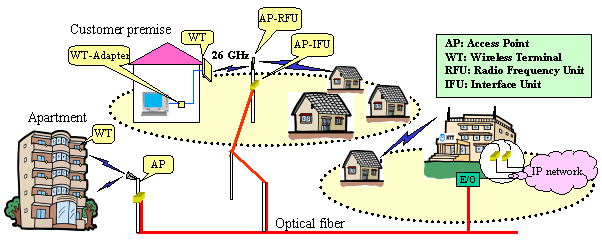
NTT provides an economical IP service quickly using optical and wireless technologies!
* Currently, this development has been completed at our laboratory.Development of Wireless IP Access System (STEP 2)
NTT Access Network Service Systems Laboratories developed the Wireless IP Access System (WIPAS STEP1), which uses the 26-GHz frequency band and combines wireless technology with an optical network. Services were made available over this STEP 1 system beginning in September 2002 when NTT East and NTT. Moreover, NTT has developed the WIPAS STEP2 that doubles the transmission rate of the STEP 1 system (the transmission capacity is 80 Mbit/s) and is implemented much more compactly. Services based on the WIPAS STEP 2 will be made available beginning in 2003.
Background
High-speed Internet access over optical fiber, ADSL, CATV, and other networks has become rapidly available in recent years. Yet there are still many users who cannot enjoy access to these broadband environments due to the difficulties posed by deploying fiber-optic cable or simply because services have not been made available in their areas due to cost considerations. With the goal of providing high-speed Internet access to these previously inaccessible pockets of users, NTT Access Network Service Systems Laboratories developed the Wireless IP Access System (WIPAS) STEP 1. To expand the WIPAS services, NTT had developed the WIPAS STEP 2.
Overview
Fig. 1 shows a service image of WIPAS STEP 2. This system provides a best-effort type IP service, and the wireless bandwidth is shared fairly among the WTs that are connected to the same AP. This system uses a quasi-millimeter-waves in the 26 GHz band, and the maximum wireless transmission rate of this system is 80 Mbit/s. The maximum transmission distance is approximately 1.7 Km (*).
APs (Access points) are installed on telephone poles, and are connected to IP networks by an optical fiber cables. WTs (Wireless terminals) are installed on customer premises. A WT is connected to PC by using Ethernet cables over a WT-adapter.
(*) Standard design values with cumulated 20 minutes of circuit interruption due to rain fall attenuation of radio signal in one year.
In Japan, the maximum transmission distance is approximately 1.2 Km.
In Japan, the maximum transmission distance is approximately 1.2 Km.

Fig. 1 WIPAS STEP 2 Service image
Future works
Services based on the Wireless IP Access System (STEP 2) will be made available beginning in 2003. In the future, we will add QoS, and adaptive modulation functions, and develop a repeater for WIPAS.
Access* We do not accept inquiries regarding this article.
First Promotion Project FWA Development Project
Toshio Saitoh (Supervisor) , Mitsuhiro Baba (Senior Research Engineer)
Yoshiyuki Yasui (Research Engineer) , Katsutoshi Nidaira (Research Engineer)
Yoshiyuki Yasui (Research Engineer) , Katsutoshi Nidaira (Research Engineer)
|
TOP |
1.Development key-factor |
